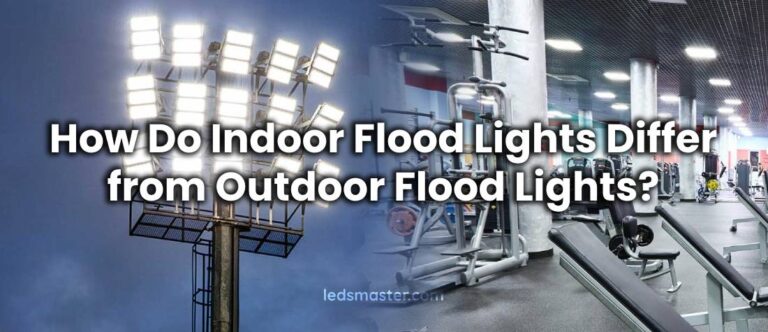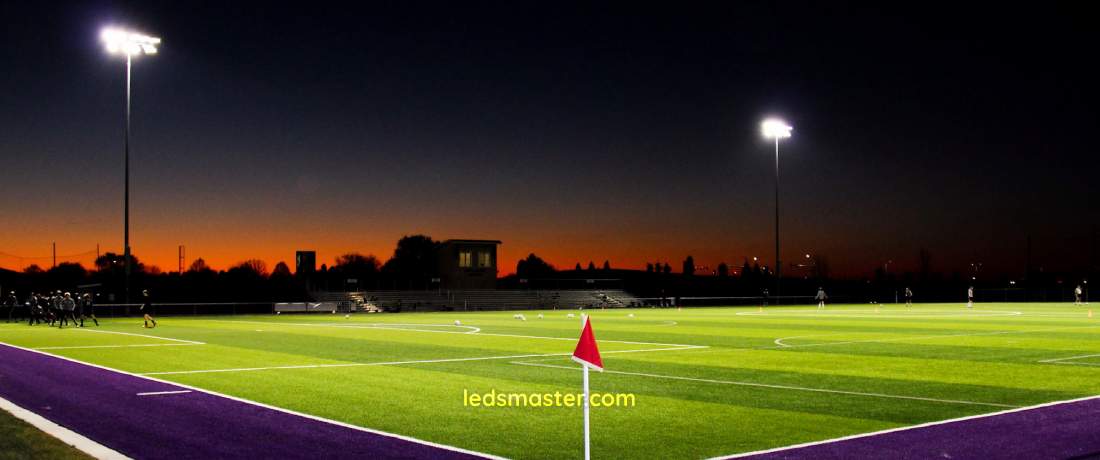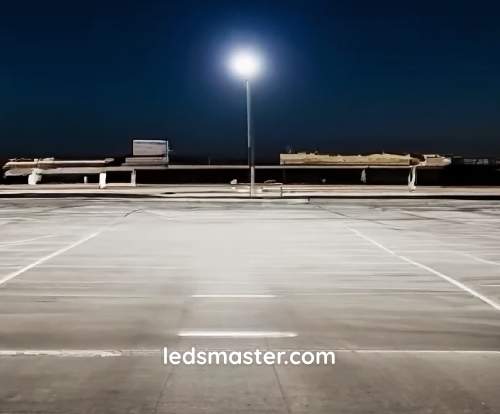
The brilliance of a well-lit area not only illuminates the physical space but also uplifts the ambiance, creating inviting and dynamic atmospheres. Delve into the essentials of flood lighting design and discover how the right features and thoughtful considerations can elevate your lighting projects to new heights of excellence and efficiency.
Get your complimentary lighting design today
Flood lighting is used in a variety of applications, from sports fields and stadiums to parking lots and building exteriors. Understanding the basic parameters and features of flood lights is essential for achieving optimal lighting performance. This article explores the key elements of flood lighting design, including lux requirements, uniformity, color temperature, color rendering index (CRI), and the essential features of high-quality flood lights.
Table of Contents
ToggleLux is a unit of measurement for illuminance, representing the amount of light that falls on a surface. Different applications require different lux levels to ensure adequate visibility and safety. Properly calculating and meeting the lux requirements for each specific application is crucial for effective flood lighting design.

For instance, recreational sports fields typically need around 200 to 300 lux to provide sufficient lighting for amateur games and practice sessions. These lux levels ensure that players and spectators can see clearly without excessive brightness that might cause glare or visual discomfort. Professional sports stadiums, on the other hand, require much higher lux levels, often up to 1000 lux or more, to meet the standards for televised events and ensure optimal visibility for both players and viewers. High lux levels in professional settings also enhance the experience by making every detail visible, thus improving the quality of the broadcast.
 Parking lots and building exteriors generally require lower lux levels, typically in the range of 50 to 100 lux. These levels are sufficient to ensure safety and security by illuminating the area without creating excessive light pollution or energy consumption. Properly calculated lux levels in these areas help prevent accidents, deter criminal activity, and create a welcoming environment.
Parking lots and building exteriors generally require lower lux levels, typically in the range of 50 to 100 lux. These levels are sufficient to ensure safety and security by illuminating the area without creating excessive light pollution or energy consumption. Properly calculated lux levels in these areas help prevent accidents, deter criminal activity, and create a welcoming environment.
Uniformity refers to the even distribution of light across a given area. High uniformity ensures that there are no dark spots or overly bright areas, which can cause visual discomfort and reduce the effectiveness of the lighting. The uniformity ratio is typically expressed as U1 (minimum illuminance to average illuminance) and U2 (minimum illuminance to maximum illuminance).
A good flood lighting design aims for a uniformity ratio of 0.5 or higher for general outdoor lighting. This ensures that the light is evenly spread, providing consistent illumination throughout the area. For sports fields, achieving higher uniformity is even more critical. A uniformity ratio of 0.7 or higher is often required to ensure consistent visibility across the entire field, allowing players to perform at their best without being hindered by uneven lighting. High uniformity in sports lighting also enhances the viewing experience for spectators, both in the stadium and watching broadcasts.

Color temperature is measured in Kelvin (K) and describes the color appearance of the light produced by a flood light. It ranges from warm white (2700K-3000K) to daylight (5000K-6500K). The choice of color temperature depends on the specific application and the desired visual effect.
Warm white light, ranging from 2700K to 3000K, creates a cozy and inviting atmosphere. This color temperature is ideal for architectural lighting, residential areas, and certain outdoor spaces where a relaxed and comfortable ambiance is desired. Warm white light enhances the visual appeal of buildings and landscapes, making them appear more welcoming and aesthetically pleasing.
Daylight color temperature, ranging from 5000K to 6500K, provides a crisp and clear illumination. This type of lighting is suitable for sports fields, parking lots, and commercial spaces where high visibility and clarity are essential. Daylight color temperature enhances the perception of detail and contrast, making it easier to see objects and movements clearly. This is particularly important in sports lighting, where players and spectators need to discern fast-moving action and subtle details.
The Color Rendering Index (CRI) measures how accurately a light source reveals the true colors of objects compared to natural sunlight. It is rated on a scale from 0 to 100, with higher values indicating better color rendering. A high CRI ensures that colors appear natural and vibrant, enhancing visual clarity and reducing eye strain.
A CRI of 80 or higher is generally recommended for most flood lighting applications to ensure good color perception and visual clarity. This level of CRI is suitable for general outdoor lighting, parking lots, and commercial spaces where accurate color representation is important for safety and aesthetics.
For sports lighting and areas where color accuracy is critical, a CRI of 90 or above is preferable. High CRI lighting enhances the viewing experience by making colors appear more vivid and lifelike. In sports settings, this can improve the visibility of players, equipment, and markings on the field, contributing to better performance and enjoyment for both participants and spectators. High CRI lighting is also beneficial for tasks that require precise color discrimination, such as security and surveillance.
The beam angle of a flood light determines the spread of light emitted from the fixture, significantly influencing the lighting distribution and intensity over a given area. Selecting the appropriate beam angle is crucial for achieving the desired lighting effect and coverage.
Narrow beam angles, typically ranging from 10 to 25 degrees, are suitable for highlighting specific areas or objects. These focused beams create intense, concentrated light, making them ideal for accentuating architectural features, statues, or signage. Narrow beam angles are also beneficial in applications where precise lighting is needed, such as in stage lighting or in illuminating small areas within a larger space.
Wider beam angles, ranging from 60 to 120 degrees, are ideal for general area lighting. These broader beams distribute light more evenly across larger spaces, making them suitable for applications like parking lots, sports fields, and building facades. A wide beam angle ensures comprehensive coverage, minimizing dark spots and providing consistent illumination throughout the area.
In flood lighting design, the choice of beam angle should align with the specific lighting requirements of the space. For example, sports fields often require a combination of narrow and wide beam angles to ensure both concentrated lighting for key areas and general illumination for the entire field. Similarly, architectural lighting might use narrow beams to highlight building details while using wider beams for overall façade lighting.

Modern flood lights often come equipped with dimming capabilities and advanced control options, enhancing their functionality and efficiency. Dimming allows for adjustable light levels, providing flexibility to adapt the lighting intensity to different needs and conditions. This capability not only improves user comfort but also leads to significant energy savings by reducing power consumption when full brightness is not necessary.
Advanced control options, such as smart lighting systems and motion sensors, further enhance the versatility and efficiency of flood lights. Smart lighting systems enable remote management of lighting schedules and intensity, allowing users to control their lighting setup from a central interface or even through mobile applications. This remote control capability is particularly useful in large facilities or outdoor areas where manual adjustments would be cumbersome.
Motion sensors add an additional layer of efficiency and security by automatically adjusting the lighting based on movement detection. In areas like parking lots or pathways, motion sensors can ensure that lights are only on when needed, thus conserving energy and extending the lifespan of the fixtures. Furthermore, motion-activated lighting can deter unauthorized access and enhance safety by providing immediate illumination when motion is detected.
Proper installation and maintenance are vital for the long-term performance and reliability of flood lighting systems. The installation process should be carried out with careful consideration of the specific lighting needs and the environment in which the lights will operate.
Flood lights should be installed at appropriate heights and angles to achieve optimal coverage and uniformity. The height of the installation affects the spread and intensity of the light, with higher installations providing broader coverage but potentially lower intensity. The angle of the lights should be adjusted to minimize glare and shadows, ensuring even illumination across the target area.
In addition to correct installation, regular maintenance is essential to ensure that flood lights continue to deliver high-quality illumination. Maintenance tasks include cleaning the fixtures to remove dust and debris that can obstruct light output, inspecting the electrical components to prevent malfunctions, and checking the structural integrity of the mounts and fixtures. Regular inspections can identify issues such as flickering, reduced brightness, or physical damage, allowing for timely repairs or replacements.
A well-maintained flood lighting system not only provides consistent performance but also extends the lifespan of the fixtures, reducing the need for frequent replacements and minimizing overall maintenance costs. Implementing a routine maintenance schedule helps ensure that the flood lights remain in optimal condition, contributing to the safety, security, and aesthetic appeal of the illuminated area.
To achieve the best results in flood lighting design, it is important to choose flood lights with certain key features. These features ensure the lights are efficient, durable, and provide high-quality illumination.
Luminous efficacy measures how well a light source converts electrical energy into visible light, expressed in lumens per watt (lm/W). High luminous efficacy is crucial for flood lights as it directly impacts energy efficiency and overall performance. High-quality flood lights should have a luminous efficacy of at least 160 lm/W. This high efficiency ensures maximum brightness while minimizing energy consumption, leading to significant cost savings in the long run.
Flood lights with high luminous efficacy are particularly beneficial for large-scale installations such as sports fields, parking lots, and building exteriors. By providing more light per unit of energy consumed, these lights reduce operational costs and contribute to sustainability efforts. Additionally, the higher efficiency means fewer fixtures are needed to achieve the desired illumination levels, simplifying installation and reducing visual clutter.
Flicker refers to rapid variations in light intensity, which can cause eye strain, headaches, and other health issues. Flicker-free operation is a critical feature for flood lights, particularly in areas where people spend extended periods under artificial lighting. High-quality flood lights use advanced driver technology to eliminate flicker, providing a stable and comfortable lighting environment.
In sports fields and arenas, flicker-free lighting is essential for both players and spectators. It ensures that fast-moving objects are clearly visible without causing visual discomfort or distraction. Moreover, flicker-free lighting is crucial for high-speed photography and video recording, as it prevents the appearance of flickering artifacts that can degrade image quality.
Glare occurs when an excessive amount of light enters the eye, causing discomfort and reducing visibility. To prevent glare, flood lights should be designed with proper optical lenses and shielding. Glare-free illumination ensures a comfortable visual experience, enhancing safety and reducing eye strain.
In sports lighting, glare-free illumination is particularly important. Players need clear and unobstructed views to perform at their best, and spectators require comfortable lighting to enjoy the event. Properly designed flood lights with anti-glare features help achieve this by directing light precisely where it is needed and minimizing stray light. This enhances the overall visual experience and ensures that the lighting does not interfere with the performance or viewing of the game.
Excessive heat can reduce the lifespan of flood lights and pose safety risks. High-quality flood lights are designed with efficient heat dissipation systems, such as aluminum heat sinks and thermal management technology. These features help maintain a low operating temperature, extending the life of the lights and ensuring consistent performance.
Low heat emission is particularly important in applications where the lights are in close proximity to people or heat-sensitive equipment. For example, in indoor sports facilities or commercial spaces, low heat emission helps maintain a comfortable environment and reduces the load on cooling systems. Additionally, efficient heat dissipation protects the internal components of the flood lights, ensuring long-term reliability and reducing maintenance costs.
Flood lights are often used in outdoor environments where they are exposed to rain, snow, and other harsh weather conditions. It is essential to choose flood lights with a high IP (Ingress Protection) rating, indicating their ability to withstand water and dust. An IP65 rating or higher is recommended for outdoor flood lights to ensure durability and reliable operation in all weather conditions.
Waterproof and weather-resistant flood lights are designed to withstand the elements, ensuring consistent performance regardless of environmental conditions. This makes them ideal for applications such as sports fields, parking lots, and building exteriors, where they must operate reliably in various weather conditions. High-quality materials and robust construction also enhance the longevity of these lights, reducing the need for frequent replacements and ensuring long-term cost-effectiveness.
Flood lighting design requires careful consideration of lux requirements, uniformity, color temperature, and color rendering index. Selecting flood lights with high luminous efficacy, flicker-free operation, glare-free illumination, low heat emission, and waterproof capabilities is crucial. Additional factors such as beam angle, dimming and control options, and proper installation and maintenance further enhance lighting performance and longevity. By prioritizing these elements, designers can create effective, efficient, and visually pleasing flood lighting solutions for various applications.